 V Corps ...
V Corps ...  Ordnance
Ordnance897th links: FRONT PAGE ...
897/3562 History ...
Camp Lee ...
Camp Shelby ...
Louisiana Maneuvers ...
Camp Murray ...
Train Trip ...
Camp Young ...
Palm Village ...
Camp Haan ...
Yanks in Britain ...
Normandy Hedgerow Cutters ...
Battle of Stavelot ...
Europe ...
Way it Was ...
WWII Memorial Dedication ...
Other WWII Stories ...
Notes and Contacts ...
gocek.org links: gocek.org ...
Christian Symbols ...
Financial Calculator ...
Football Pools ...
Captain Kangaroo ...
Webcam ...
Blogs ...
Statistics ...
Site policy information ...
Happy Cello Day!
These condensed versions of the histories were compiled by William E. Lake from the full history of the 897th as furnished by William Kemnitz who was the official historian for the 897th and who also made available the history of the 3562nd Ordnance Co. by William E. Lake.
History of the 1st Army, V Corps, 86th Ordnance Battalion,
897th Ordnance Heavy Automotive Maintenance Company
![]() 1st Army ...
1st Army ...  V Corps ...
V Corps ...  Ordnance
Ordnance
[A graphic of waving blades of wheat is displayed here with the text, "True happiness consists not in the multitude of friends, but in their worth and value." -- Ben Johnson]
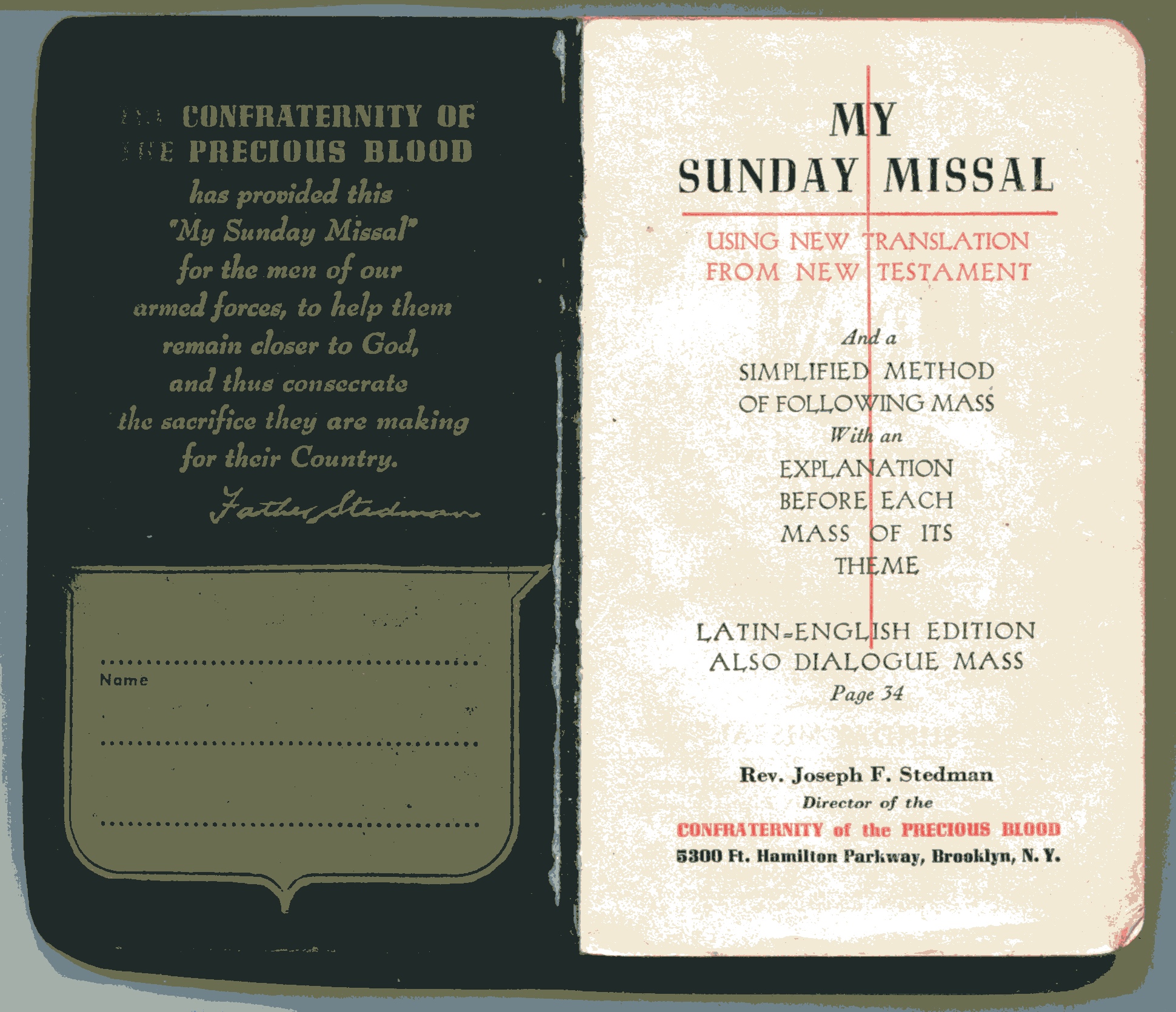 1938 Missal
1938 Missal
The Company was activated 16th June 1941 at Camp Shelby, Miss. as Co. C, 57th
Quartermaster Regiment (HM) and on same date 2nd. Lt. Russel was assigned as
Commanding Officer - no other personnel. On 29th June 3 officers and 198 EM
from 8th QM Training Regt., Camp Lee, Va. were assigned and 1st Lt. Bass
assumed command of Co. On 4 Aug. the Co. left Camp Shelby to participate in
1941 Louisiana Maneuvers. The Co. set up repair shops at Baton Rouge, Lake
Charles, Crawley and Pitkin, La. Maneuvers completed, the Co. arrived back at
Camp Shelby 5 Oct. Lt. Bass was transferred out on 9 Oct. and the Co. got a new
CO in Capt. Guetschow. Pearl Harbor Day, Dec. 7 the Co. was performing usual
garrison duties at Camp Shelby.
On 20 Dec. 41 the Company's 3 officers and 191 EM left Camp Shelby, arriving at Camp Murray (Ft. Lewis) Wash. On Christmas day. The Co. acquired Lt. Bassett, but while at Camp Murray lost all its officers except Capt. Guetschow. The Co. with 1 officer and 196 EM left Camp Murray 9 Apr. 42 arriving Indio, Calif. 12 Apr. for 6 weeks of Desert Warfare training, which turned out to be more like 15 months. In Camp Young (The Desert Training Center) in the heart of the Mojave 25 miles to the nearest town, the Co. lived in tents and operated 4th echelon shops including engine and heavy unit rebuilding for army units engaged in desert maneuvers. Automotive maintenance units were transferred from Q M to Ordnance so the Co. was redesignated 897th Ord. HM Co. (Q). While at Camp Young the Co. underwent many changes in personnel - Capt. Emanuel became C.O., Lt. Kohlenberg took several men as a Cadre for a new unit, several men went to Officer Candidate School, Capt. Guetschow, Lts. Epperson, Jackson, Leonard, Bernier and Atwood all left; Lts. Kemnitz, Lake, Lewenthal, Klockow and Lafay all joined.
The Co. left Camp Young 5 Feb. 43 with 6 Officers and 277 EM and arrived at One Thousand Palms, Cal., near Indio, on same day. The Co. at this location operated as a communications zone maintenance unit for about a month, moving to Palm Village area on 8 Mar. Here the Co. set up shop and lived in simulated combat conditions, with some digging in and everything camouflaged. Numerous mock air raid lent realism to the situation. On 15 June 43 the Unit was re-designated for the last time to 897th Ord. Heavy Automotive Maintenance Co. 16 June the Co. celebrated its 2nd. anniversary with a chicken dinner and party (commonly known as beer party). 14 July the Co. suffered its first casualty when Pvt. Clifford L. Moore was killed in the overturning of a truck. The Co. came under a new T/O, 9-197 so 40 men were lost through transfer. On 24 July T/Sgt. Art Grochowski, a charter member of Co., was discharged to accept appointment as W O and assigned to the Co. On 25 July 43 the Co. moved to Camp Haan, Calif., near Riverside and across road from March Field, a B 24 bomber training base. The next day, 26 July, a B24 crashed into our motor pool of 52 vehicles and all our shop equipment. The Co. received a Commendation from C G Camp Haan, Major Gen. H. R. Oldfield which read as follows:
To Co. 897 HAMCO- "You and the members of your command are hereby commended on the alertness shown when a Liberator Bomber crashed at Camp Haan on 26 July 1943. By quick action and soldierly conduct the 897 Ord Ham Co. saved many thousands of dollars worth of valuable Government equipment."
On 1 Oct. 43 the Co. was alerted for overseas movement via NYPE. So with 6 officers, 1 WO and 204 EM the Co. departed by rail at 1500 19 Oct. 43 for 5 days in our own "private" troop train, arriving Camp Shanks, N.Y. 0730 24 Oct. Eighteen days were spent at Camp Shanks in final preparation for overseas movement and all personnel received night passes several times, most visiting NY City.
So - 2300 11 Nov. 43 the Co. boarded the English troop ship Andes at NYPE - landing at Liverpool England 20 Nov. debarking from ship 1230 21 Nov. The Co. traveled by rail to Gloucester moving into Camp Reservoir at south eastern edge of the City. During our 8 months in England we drew all our authorized equipment and performed 4th echelon maintenance to Units in our area in addition to much specialized training. We lost to transfer Capt. Emanuel and Lt. Lewenthal, gaining Lt. Snyder as CO and Lt. Cegan.
30 Mar 1944 the Co. was alerted for overseas voyage, so the next 45 days were spent in final preparation for our part in Allied invasion - specifically FIRST US ARMY service troops. The Co. was issued 126 additional vehicles for replacement of combat lost vehicles, and received 44 additional men as drivers. All trucks and trailers were loaded with extra replacement parts - tank engines, tank tracks, etc. 8 trailers even carried 8-M7 snow buggies to be used in swamp areas. Many of these vehicles were loaded to 2, 3, and 4 times over rated capacity. So the Co. left Camp Reservoir 13 June 44 with 109 vehicles and 54 trailers arriving Southampton 2030 14 June. Here, starting immediately the Co. personnel loaded 2 LSTs to capacity and part of a third. All three sailed on 15 June as follows: LST #494 at 0400 with 3 officers, 90 EM and 88 vehicles; LST #5 at 0545 with 3 officers, 1 WO, 100 EM and 80 vehicles; LST #543 at 1045 with 1 officer, 14 EM and 5 vehicles. All landed at Omaha beach of Normandy coast, the first unloading at 2330 15 June. In driving vehicles off the LST ramp some encountered 3 to 4 ft. of water and only one vehicle was lost - one of our truck tractor 10 ton semi-trailer parts vans, loaded primarily with "parts common". Loss of this valuable cargo was never fully recovered during the subsequent months. The Company's landing on D+9, 15 June, made it the first Heavy Maintenance unit on the Continent.
The Co. quickly set up shop in an orchard 2 miles east of the little town of Treviers, our first operation as a maintenance unit in the Combat Zone. For several days we also acted as a Depot Co. as none had arrived yet, and we issued most of the extra vehicles and parts we had brought over to combat units during the first 3 or 4 weeks.
One 13 July the Co. moved to Cerisy Forest where our welders worked several days and nights making steel attachments to be mounted on front of tanks in order for them to plow through the hedge rows of Normandy. On 24 July the Co. suffered its first casualty, T/5 William P. Roberts was seriously burned, resulting in his being evacuated to England.
With the FIRST ARMY'S breakthrough at St. Lo the 897th moved far and often during the next month - clear across France - convoying through Paris 2 Sept., making 7 stops of from 2 days to a week duration: 3 Aug. near St. Lo; 10 Aug. Vire; 21 Aug. Sees; 30 Aug. Saclay; 2 Sept. Senlis; 4 Sept. Laon; 8 Sept. Cliron. During this time and all the moving, the Co. managed to perform its mission - support of V Corps, FIRST ARMY.
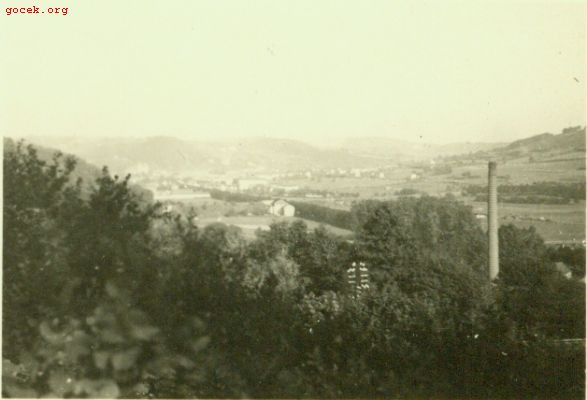 Malmedy, 1944.
Malmedy, 1944.
On 16 Sept. the Co. moved into Belgium - Sibret, 5 miles SW of Bastogne. Here
the rains came and it became impossible to operate shops or move vehicles off
of roadways. So, on 27 Sept. we moved into Bostogne Barracks where we enjoyed
our first buildings and covered shops since landing on the Continent. This only
lasted 6 days as the Co. moved on 3 Oct. to Malmedy for 1 day and then to
Stavelot where we set up shop in the small railroad yards and depot. Here we
settled down for a month and a half while the Allied Armies re-grouped to let
supplies catch up after having outrun their supply lines. The Company's
workload continued as always to be very heavy, the weather was extremely cold
with much snow. Also, we encountered Hitler's first Robot bombs, the V1.
Unofficially it is believed that our own Silas Howerton shot down one of these
V1 robots while on guard duty one night.
On the afternoon of 16 Dec. enemy shell fire was directed at the hills between Malmedy and Stavelot. All during the night and most of the 17th, American Armor was moving past us - BACK. Our CO, Capt. Snyder had left us due to illness and Lt. Kemnitz had ordered preparations be made to move quickly if necessary. During suppertime 17th Dec., word was received from 86th Ord. Bn. to move to Stoumont Station, 12 miles west. Thanks to our earlier preparation, we did manage to move most of our equipment by shuttle, the last detail departing at 0400 18 Dec. with entrance to Stavelot of German Armor. This was the beginning of the "Battle of the Bulge: or the German breakthrough. During the next 3 days we were in quick retreat and later we learned that we were barely one step ahead of enemy advancement. During movement from Stavelot to Stoumont Station we picked up 56 men lost from their units and some 2 dozen tanks and other armored vehicles were added to our already approximately 150 assorted vehicles. Later that morning (18 Dec.), leaving 2 armored vehicles and 10 Bazooka teams behind, the Co. moved to Bomal, spending one night and then moving to Ocquier. After being at Ocquier only a few hours we were again ordered to move - this time west of the Meuse River, to Eghezzee. On 24 Dec. the Co. moved to Herstel just outside of Liege, setting up shop in factory buildings of Fabrique Nationale (Browning Arms). Here the V1 "Buzz" bombs were quite frequent as Liege and Antwerp were Hitler's main targets. The factory buildings here afforded us the best shop facilities sine leaving England and our maintenance records showed increased production despite very cold and snowy weather. Then too, we almost daily supplied up to 40 men delivering vehicles and other allocated equipment to combat units.
Having been in Herstal 6 weeks the Co. moved 25 miles east to Verviers 8 Feb. Here, in addition to operating our regular 4th echelon maintenance shop we operated V Corps Forward Collecting Point. This Collecting Point operation is of particular interest to the writer as I was put in charge of its operation. Here briefly is what I think is truly an amazing piece of work for 18 days with 27 men and 20 Belgians we evacuated the following equipment: 224 G.P. vehicles; 48 Combat (Track laying) vehicles; 21 Guns; 13 Gun tubes; 8324 rifles; 9128 misc. barrels, clips, machine guns, instruments, etc.; 29 truck loads and 25 van loads tires; 28 truck loads tank track; 8 truck loads tank track connectors; 6 truck loads batteries; 29 rail cars of engines, axles, etc., and stripped a total of 68 vehicles. All this was accomplished by the following personnel: T/Sgts Ferrara and Fishback; Gaulke, Deneavage, Hammond, Eggleston, Durst, Hanna, Goodner, Sage, Franklin, Stockstill, Deusner, Leach, Benjamin Meyers, Elmer Wright, Tabachnick, Granger, Ashworth, Roberts, Manning, Bechdol, Kiper, Thompson, Dietz and Blevins.
Relinquishing control of the collecting point 22 Feb. the Co. moved across town to Dison and set up shop in a German air depot. 17 Mar. the Co. crossed the Siegfried Line into Germany setting up shop in a small car body factory at Mecharnich. Here only 9 days we moved to Wiebenthurm on the banks of the Rhine into a cement plant. In just 3 days we crossed the Rhine on the Victor Pontoon Bridge, the longest of its type ever built, and settled into Giessen 31 Mar. in a badly bombed German Army Garrison. 3 Apr. the Co. moved 38 miles to the site of a large German munitions plant in Forest Neustadt where we were surrounded by thousands of tons of explosives. A week later, 11 Apr. the Co. moved 78 miles to Hann Munden. While here, on 16 Apr. the Co. was awarded "The Meritorious Service Unit Plaque" for superior performance of duty in the accomplishment of exceptionally difficult tasks for the period 24 June 1944 to 21 Aug. 1944.
24 Apr. we moved another 90 miles to Muhlhausen where we enjoyed good shop building, barracks and good spring weather.
In order to keep up with V Corps advance the Co. left Muhlhausen 5 May for Coburg, and again 7 May moved 75 miles further east to Weiden, near the German-Czech border, with shops in large railway yards. Here 8 May, VE Day was celebrated.
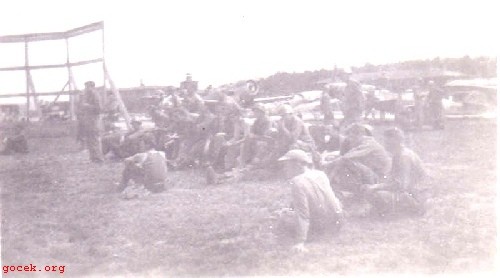 A week later 13 May the Co. moved 70 miles east to Pilsen,
Czechoslovakia, setting up shop in a huge Luftwaffe hangar at Pilsen airport.
After a year and a half assignment to First US Army we were relieved and
assigned to Third US Army (Patton). Our long dormant baseball and softball team
got cranked up again and played all comers and I think beat 'em all.
A week later 13 May the Co. moved 70 miles east to Pilsen,
Czechoslovakia, setting up shop in a huge Luftwaffe hangar at Pilsen airport.
After a year and a half assignment to First US Army we were relieved and
assigned to Third US Army (Patton). Our long dormant baseball and softball team
got cranked up again and played all comers and I think beat 'em all.
Note: Howard Hammond's grandson Rich provided photos. We see the guys sitting along the third base line, with an airplane in the background (center). J C Davies sits in a repaired German aircraft. Julian Gocek recalls that they played fast-pitch softball, and also that Davies was killed in the course of working on that airplane.
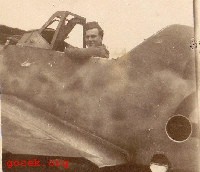
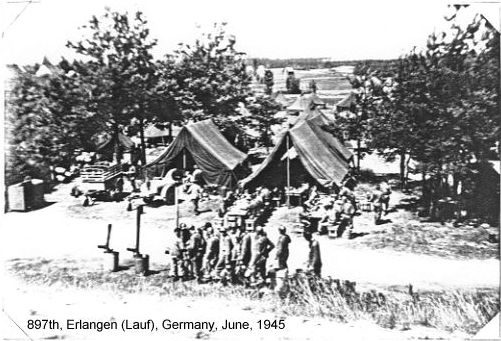 14 June the Co. had to leave Pilsen as we were in Russian Occupation Zone, and
moved back into Germany at Buchenbuhl - just outside Nurnberg.
14 June the Co. had to leave Pilsen as we were in Russian Occupation Zone, and
moved back into Germany at Buchenbuhl - just outside Nurnberg.
Note: the photo comes from a reunion souvenir booklet, labeled as shown. Erlangen, Lauf, and Buchenbuhl are fairly close, along a 30 mile stretch.
Here we were in the open with no cover or buildings and the workload increasing daily so 24 June we moved into Nurnberg in and around the Bismarck School. 27 June the Co. received participation credit for the "Ardennes", "Rhineland", and "Central European" campaigns. Those 3 added to our previous "Normandy" and "Northern France" campaign awards gave everyone additional points which resulted in 134 EM and all 7 officers with 85 or more points - 85 being the minimum number to qualify for rotation back to the States. Right away men and officers started to be transferred out to different units. On 5 July 125 men were transferred to 3562 Ord. HAM Co. and 7 July Capt. Snyder, Lts. Cegan, Klockow, Lake, and WO Grochowski were transferred to the same unit.
From this date 9 July we have no further record of the 897th so thus ends the history of this great Maintenance Unit after 4 years, 1 month through good times and tough times and many, many memories.
William E. Lake
April 4, 1978
HISTORY OF 3562 ORD. HAM CO.
This unit was activated 29 Jan. 1944 at Camp Polk, La. as 3562 Ord. Medium
Maintenance Co. 19 Feb. 44 the Co. moved to Camp Forrest, Tenn. and
subsequently to Tenn. maneuvers. Back to Camp Forrest and on 26 May the Co. was
re-designated 3562 Ord. Heavy Automotive Maint. Co. and on 6 July moved to Camp
Shelby, Miss. Here the Co. was alerted for overseas movement 31 Oct. 44 and on
23 Dec. left by rail for an east coast Staging Area. 1 Jan. 1945 the Co. left
Camp Kilmer, NJ and at NYPE, Brooklyn, boarded Liberty Ship Sea Robin, sailing
3 Jan. Crossing the Atlantic in 12 days the Co. docked at Southampton but
without debarking sailed again 16 Jan., landing same date at LeHarve, France.
The Co. left Camp Lucky Strike 1 Mar. for Luxembourg and then moved as follows:
14 Mar. to Trier, Germany
24 Mar. to Sprendlingen, Germany
30 Mar. to Langen, Germany
8 Apr. to Lachs, Germany
16 Apr. to Eisfeld, Germany
21 Apr. to Berneck, Germany
While at Berneck the Co. took 15 German prisoners. 29 Apr. the Co. moved to Wackersdorf and was here when Germany surrendered. When the point system was announced only 1 man had as many as 85 points.
On 2 June the Co. moved to a large aluminum factory just outside the city of Schwandorf where the mass transfer of personnel with 897 Ord. HAM Co. began. On 7 July the Co. lost its first and only CO, Capt. Gabe E. Frand to the 897th, and Capt. Snyder assumed command 9 July.
On 18 July the Co. was alerted for movement by motor convoy with all T/E equipment to Naples, Italy for further movement by water to Casablanca, French Morocco, North Africa. On 20 July 38 more men were assigned, bringing the unit to T/O strength and all men and officers had 85 or more points.
At 0510 hours 22 July with 187 EM and 7 officers and all equipment, the Co. departed Schwandorf on its first leg of a 1200 mile trip, enjoying many sights such as The Alps through Brenner Pass, Leaning Tower of Pisa, Rome and Naples. Our night bivouacs were: Garmisch Partenkirchen, Germany; Verona, Italy; Pisa; Grossetto; Rome; Caserta and Staging Area No. 5 Naples, arriving 8 July. During the 7 days of convoying the maintenance crews were kept busy keeping the vehicles rolling. One GMS engine was replaced and 2 of the truck tractor engines required valve regrinding, all this was accomplished at bivouac stops, sometimes working far into the night. Hot weather was experience since descending the Alps, so cotton khaki clothing was procured at Naples, the first time we had worn khakis since leaving Calif. - almost 2 years. The sights of Naples and adjacent ancient buried city of Pompeii were enjoyed for 3 days.
1 Aug. the Co. boarded Liberty Ship MV Cape Beale, vehicles and equipment having been loaded the day before, and departed Naples. After 5 days living on the open deck, enjoying perfect weather, the Cape Beale docked in Casablanca harbor. All equipment was unloaded that day, 5 Aug., and moved to Ordnance Camp 407. The unit was relieved from assignment ETO and assigned to African Middle East Theater and further assigned to North African Service Command. The Company's mission was operation of the Service Command's Base Depot and Shop, doing 5th echelon rebuild. Theater Headquarters had not expected a Category 1V Unit as there was a 6 to 8 months job here, so action was started to get the Co. replaced. On 18 Aug. a Theater telegram was received, ordering the Co. to the US. So the next 10 days all the T/E equipment and spare parts were turned in and all preparations made to deactivate the Unit in the US.
3 Sept. 137 EM and 3 officers left Casablanca by air (Green Project) Via Natal, Brazil-Miami. The remainder of men and officers followed sometime later and apparently Capt. Snyder saw to the deactivation of the Unit.
William E. Lake
10 April, 1978
[Editor's note: I had the great pleasure to speak with William Lake in 2008. I wondered about William Kemnitz's "full history" used by Mr. Lake to write this condensed history. Mr. Kemnitz was tasked during the war to write a monthly synopsis of Company activities, but only a paragraph or two each month, so this condensed history, augmented by some memories of Mr. Lake, is essentially as complete as the full history.]